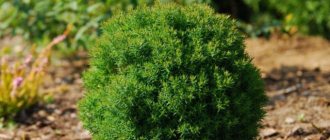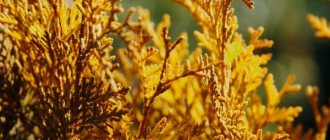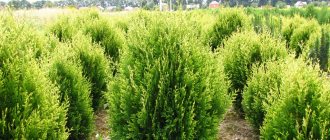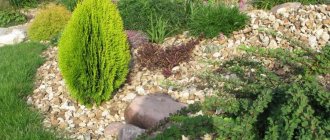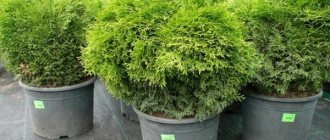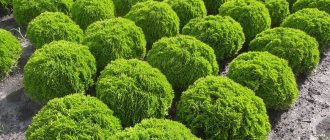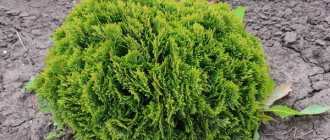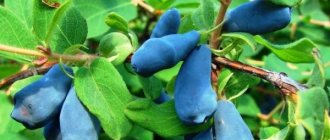» Shrubs and trees » Thuja occidentalis Miriam - a new type of coniferous crop
0
1028
Article rating
Today, Western thuja Miriam is one of the most popular crops for landscaping balconies and garden plots in Germany, Switzerland, and Denmark. The young variety was bred on the basis of the popular Danica variety; it quickly spread in Europe. The main advantage is the beautiful crown in the shape of a ball with thick and pleasant-to-touch needles.
- Care
- Watering
- Feeding
- Mulching and loosening the soil
- Trimming
- Preparing for winter
- Reproduction
- Diseases and pests
- Use in landscape design
- Reviews
Thuja occidentalis Miriam - a new type of coniferous crop
Brief information about the variety
- Needle color : yellow-green in summer, brown-green with a hint of bronze in winter.
- Height : 80 cm.
- Crown width : 80 cm.
- In what regions does it grow : in all territories included in climate zone 4.
- Planting features : sunny area (possibly with slight partial shade) with moderately moist soil.
- Immunity : strong.
- Life expectancy : 30 years.
What is wrong with thuja “Miriam”?
Fungus . The consequence is that the shoots turn brown. The disease is detected early in the spring. The scales begin to turn yellow. If the problem is not addressed in time, the shoots will begin to turn brown and die. Damaged branches are cut off and burned. The seedlings need to be fed. And add lime to the soil. It is also necessary to spray the crown 2-3 times/14 days with a solution of the drug “Fundazol” (0.2%).
Fungi in the soil can, as a rule, “contribute” to fusarium rot in the root system of a variety. Treatment is carried out with the preparation “Zircon”. It helps increase immunity to diseases. The fungicides “Hom” and “Kartotsid” are also used.
To prevent the shoots from drying out, thuja is treated with preparations containing copper.
Description of the plant
Full name: Thuja occidentalis Mirjam.
The variety is dwarf, characterized by slow growth. Unpretentious, immune to negative urban conditions and sudden climate changes.
Description of an adult plant:
- the crown is spherical, compact, neat, reaching 0.8 m in diameter;
- the needles are soft, vertically located, the needles fit tightly to each other;
- the color changes seasonally, in the warm season it is green with a warm yellow tint, in the cold season it acquires a green-bronze color;
- annual increase in height is no more than 10 cm.
general characteristics
Thuja occidentalis Miriam is a compact shrub, reaching 0.7-0.8 m in width and height. It grows quite slowly, about 5-7 cm per year. The shape of the crown is spherical, with dense dense branches directed upwards.
The needles are scaly, shiny, golden-green in color. By winter it turns dark orange or bronze.
Growing regions
Tuika is characterized by high winter hardiness. It can be grown in most regions of Russia (from climatic zones 1 to 4 at temperatures down to -33°C).
In the southern regions, it is necessary to pay attention to regular watering and shade the tree from direct sunlight.
Landing
In order for Western thuja to correspond to the varietal decorative qualities, it is necessary to adhere to planting rules. It is important that the soil in the chosen location is of high quality.
A seedling with closed roots can be planted from mid-spring to autumn, and with an open root system - only in the spring, so that the roots have time to take root during the warm period.
Selection of seedlings
The best option is a seedling aged 3-4 years, which already has a mature and fairly strong root system.
When purchasing, you need to make sure that the shoots and roots are not injured or affected by infectious spots or traces of rot.
Preparing the site
The decorative effect of the Miriam variety depends on the planting location. A sunny area with slightly acidic soil is preferable. With a lack of lighting (up to 6 hours a day), the bush falls apart, loses its beautiful spherical shape, and becomes excessively elongated with little formation of side shoots.
If the soil cover in the selected area is heavy, if groundwater is close to the surface, then be sure to make a drainage about 20 cm thick.
Landing technology
Plants need good care
First you need to prepare nutritious soil, including turf, peat, sand in a ratio of 2:1:1. The substrate is enriched with a mineral complex (5 g per 1 kg of land) or the drug “Nitroammofoska” (100 g per seedling).
Step by step procedure:
- 2 weeks before work, dig a hole about 70 cm deep, its diameter should be slightly larger than the volume of the roots with a lump of earth;
- If necessary, pour drainage into the hole (expanded clay, gravel, brick chips);
- insert the seedling, cover it with the prepared substrate (the root collar is placed at the level of the soil surface);
- the soil is compacted and watered abundantly;
- The area around the plant is covered with mulch (sawdust, peat).
Thuja "Miriam": when to plant?
Thuja Miriam in a flowerbed
If the spherical thuja Miriam was bought in a container, then you can plant it at any time period, from April days to October. Plants with an open root system have poor tolerance to picking. For this reason, it is recommended to plant them in the spring to ensure successful rooting during the summer.
Care
In order for the thuja to retain its decorative qualities, its care must be of high quality. Moderate fertilizing, regular watering, sanitary pruning, and preparation for the winter period are required.
Watering
The frequency of the procedure is determined by climatic conditions. Typically, watering is done after the soil has dried to a depth of 1–2 cm. The soil should remain moist, but waterlogging is unacceptable.
When growing on a plot in dry weather, sprinkling is useful; when placing conifers on a balcony, spraying with lukewarm water is useful.
Feeding
Feed the bushes in the second half of spring. Mineral complexes are used. In early autumn, potassium is used for feeding.
You should not fertilize the soil under the conifer with humus, mullein, or urea.
Mulching and loosening the soil
Mulching helps keep the soil moist. Conifer bark, nut shells, and sawdust are used as mulch.
Trimming
Sanitary pruning is carried out in early spring, injured and dead shoots are cut off.
To give the crown a beautiful and compact shape, shaping is carried out (the main thing is not to cut off more than a third).
Preparing for winter
A young Miriam bush growing on the site can suffer from sharp frosts, be damaged under the weight of a snow cap, and get sunburn in early spring. To avoid such troubles, you should cover the conifer with fabric material and wrap the crown with rope.
When growing a tree on a balcony in a frosty winter, the roots may freeze because the potting soil freezes through.
To prevent the death of the root system, the pot is wrapped in thick insulation, polystyrene foam, and straw bedding. Moreover, it must be placed under the bottom of the container.
Progress
It is necessary to dig a hole for planting depending on the size of the plant’s rhizome. The root system should spread freely throughout the hole. Prepare a hole for planting. Make a drainage system (if necessary). Place the plant in the center.
Cover the roots with a prepared soil mixture, which consists of leaf soil, sand, peat in a ratio of 2:1:1. Add a complex of minerals to the mixture (5 g/1 l of mixture). Next, water. And also mulch the tree trunk circle. The root collar should be flush with the surface layer of soil.
Reproduction
Thuja propagates by cuttings
The optimal but long-term method of propagating a crop is by seed. In order for the seeds to turn into seedlings ready for transplanting into open ground, you will have to wait 3 years. Therefore, gardeners prefer to propagate conifers by cuttings and layering.
The cuttings chosen are strong and half lignified. They are cut off in the morning or in non-sunny weather so that a piece of bark remains on the cut. It contains nutrients necessary for rooting.
The selected material is planted at an angle of 60° in a soil mixture made up of equal amounts of sand and peat. Before planting, it is advisable to soak the cuttings in a growth stimulator.
The optimal air temperature is 23 - 25°C.
They are propagated in open ground using the layering method. This is not possible in a pot, as it requires more space to accommodate it. But some owners place another container next to it and bend the shoot towards it. The cuttings are freed from needles, treated with a growth stimulator, bent down, covered with earth, and watered. After the roots appear, they are cut off from the mother bush.
Western thuja Miriam: methods of propagation of the variety
Reproduction of wild plants occurs by seed. But shrubs grown by humans are recommended to be propagated in other ways. Namely: petioles, layering.
Reproduction by seed takes a very long time. The result is a shrub that has not fully inherited the characteristics of its mother. Or he didn’t inherit anything at all.
Diseases and pests
The immunity of coniferous crops is strong. In rare cases, bushes are affected by insect pests and fungal diseases.
Fungal diseases in the spring may include Schutte and Fusarium. Symptoms: paleness, later browning of needles, shedding. Diseased branches are cut off, and the soil around the trunk is treated with lime. Treatment is carried out with fungicides “Topsin” and “Hom”.
For prevention in the spring, Bordeaux solution (1%) is used.
Insects that can attack are false scale insects and aphids. The drugs Karbofos and Actellik are used against the first. Treatment twice with an interval of a week. The insecticides “Karbofos” and “Decis” are used against aphids.
What pests and diseases are most dangerous for thuja?
Western thuja, planted according to agrotechnical rules, almost does not suffer from the invasion of harmful insects and is rarely bothered by diseases. But still, plants should always receive support from the gardener: sanitary pruning, spraying for preventive purposes, timely disposal of waste. If pests and fungal diseases make themselves known, these unfavorable factors should be destroyed with special means. The main thing is not to waste time.
In the first days of spring, fungal diseases often appear. They are easy to see, the scales of the needles begin to turn yellow, the shoots turn brown and gradually die off. If such signs are detected, the damaged parts of the plant should be immediately removed and limestone should be added around the trunk. For preventative purposes, thuja must be treated with a foundationazole solution in the summer.
Spots have appeared on the plant, it quickly begins to lose its decorative appearance - this is a dangerous and difficult to remove pest called thuja false scale. In addition to pine needles, it also destroys cones. Spraying with karbofos or actelik will help in the fight against scale insects. Karbofos is effective against a massive invasion of thuja aphids; the first sign of its appearance is considered to be yellowing of the needles. You can quickly get rid of it using the drug “Decis”; it must be carefully sprayed onto the crop.
In Ukraine, where the soils are rich, the most dangerous pest of ornamental plants, including thuja "Miriam", is the cockchafer, also called Khrushchev. In one day, a Khrushchev larva can completely render the roots of a young seedling unusable. Pests can be destroyed by pouring under the roots into the soil and treating the crown with one of the preparations based on the substance imidaclopril - “Prestige” or “Antikhrushch”, “Aktara” is also suitable. Procedures are recommended to be carried out every 40-60 days, starting in early spring.
Thuja occidentalis "Miriam" has long become one of the favorite plants of owners of summer cottages. Their reviews of this beautiful creation of nature are only positive; for many people, the thuja globulus is the simplest, most irreplaceable and, at the same time, unique plant. This evergreen beauty makes the area adjacent to buildings, as gardeners say, bright and lively, always fitting into landscape compositions. Thuja northern "Miriam", the cultivation of which is accessible to everyone, truly deserves such praise.
Use in landscape design
The compact coniferous crop looks best in small compositions. Looks great next to decorative stones, heather species, trees and shrubs used in landscape design to create a Japanese style.
In urban environments, the unpretentious conifer is popular as a landscaping element for balconies and terraces. The pot or container is chosen from a natural material: ceramic, wood. Do not take containers made of plastic or metal.
Western thuja Miriam (thuja occidentalis mirjam)
